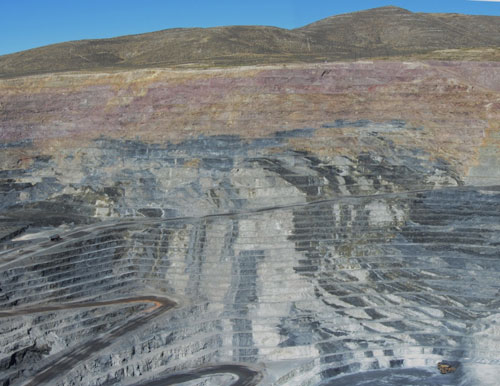
Ralph J. Roberts Center for Research in Economic Geology (CREG)
University of Nevada, Reno
Be on the inside! Join CREG!
History of CREG

Truncated nose of Conelea Anticline, the main ore control at the Megapit Carlin-type gold deposit at Newmont’s Twin Creek Mine.
The idea to create a center for research in economic geology at UNR was spawned by Nevada mining industry geologists in 1994, mainly to address the need to better understand Carlin-type gold deposits (CTGDs). Key people in the initial creation of CREG included Ron Parratt (Santa Fe Pacific Mining), Odie Christensen (Newmont Mining), and Andy Wallace (Cordex), as well as Steve Peters (USGS) and Jim Hendrix (Dean of the Mackay School of Mines). Soon after, Rich Schweickert, Chair of the Department of Geological Sciences, played a major role in the formulation of the center, serving as acting director. During this time the concept of CREG is modeled after the successful Mineral Deposits Research Unit at the University of British Columbia. The basic structure and administration of an industrial associates program was laid out by an increasingly larger group composed of people from industry, UNR, and the USGS. At this time the group recognized the need to hire a director and began to propose several research topics. The research topics were not only conventional “case studies” of individual ore deposits, but, importantly, point out the need for more regional, thematic studies such as stratigraphy, igneous rocks, role of carbon, chemical modeling, etc.
Also in 1995, Mary Beth Gentry, who was Director of Development at Mackay, and others began negotiations with Ralph Roberts to move an endowment to UNR to help fund CREG. Ralph Roberts, a pioneering geologist with the U. S. Geological Survey, is credited with pointing out the potential for carbonate-hosted disseminated gold deposits in what is now the Carlin Trend. Based on a publication and a Geological Society of Nevada presentation by Ralph, John Livermore and Alan Coope discovered the original Carlin mine for Newmont Mining in 1961. After his retirement from the USGS, Ralph played key roles in many discoveries in the 1980s, including the Marigold Mine. Ralph was considering moving the “Steven Arland Roberts Endowment for Research in Economic Geology”, a gift that he made to Harvard University in honor of his son who passed away during his doctoral studies in ore deposits at Harvard. Ralph was looking for another home for the endowment, after Harvard ended its economic geology program. By late 1995, the center became known as the Ralph J. Roberts Center for Research in Economic Geology, or “CREG” for short.
In 1996 nine CREG-funded projects were initiated, which included UNR PhD theses, UNR and UNLV MS theses, and faculty research and data compilation. Funds were almost entirely from industry and the USGS. During its initial year, 12 companies contributed to CREG. Later in 1996, Tommy Thompson was hired as the first Director of CREG, and in December, the first annual CREG meeting was convened. In 1997 the “Steven Arland Roberts Endowment for Research in Economic Geology” was formally transferred from Harvard to UNR, giving CREG some longer term financial stability. The next five years were the “golden years” of CREG, during which annual contributions peaked at $228,000 and the number of companies peaked at 18. Besides companies, individuals such as John Livermore made donations as well.
Starting in 2001, after three years of an average $280/oz gold price, the amount of contributions and contributing companies began to decrease, mainly because of consolidation in the industry. The number of major companies exploring and operating in Nevada had greatly diminished by 2006. Amazingly during these difficult times Tommy Thompson continued to elicit annual contributions for the CREG program, and students continued to receive their degrees. Since 1996 CREG has funded the completion of 35 MS theses (4 from UNLV) and 4 PhD theses. The majority of those students are still working in the mining industry, many in Nevada. In December of 2012, John Muntean replaced Tommy Thompson, who served 16 years as the Director of CREG. The mining and exploration industry is very different from 1994, yet many of the same technical challenges remain. CREG will continue to transform but with much of the same original vision that Parratt, Christensen, Wallace, Schweickert, and others had in helping sustain Nevada’s vibrant mining industry.